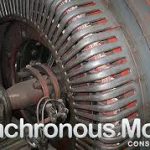Synchronous Motors Objectives Part 01
01 . Synchronous motor can operate at Lagging, leading and unity power factor only.
02 . An unexcited single-phase synchronous motor is reluctance motor.
03 . The maximum power developed in the synchronous motor will depend on rotor excitation supply voltage and maximum value of coupling angle.
04 . In case the field of a synchronous motor is under excited, the power factor will be lagging.
05 . A synchronous motor is switched on to supply with its field windings shorted on themselves. It will start as an induction motor then run as synchronous motor.
06 . When the excitation of an unloaded salient pole synchronous motor gets disconnected the motor will stop.
07 . The damping winding in a synchronous motor is generally used to prevent hunting and provide the starting torque.
08 . The back emf set up in the stator of a synchronous motor will depend on rotor excitation only.
09 . A synchronous motor is a useful industrial machine on account of which of the following reasons.
● It improves the power factor of complete installation.
● Its speed is constant at all loads, provided mains frequency remains constant.
● It can always be adjusted to operate at unity power factor for optimum efficiency and economy.
10 . Which of the following is an unexcited single-phase synchronous motor reluctance motor.
11 . An over excited synchronous motor always draws current at leading power factor.
12 . With the increase in the excitation current of synchronous motor the power factor of the motor will improve.
13 . The armature current of a synchronous motor has large values for both low and high excitation.
14 . A synchronous motor is switched on to supply with its field winding shorted on themselves. It will start as induction motor and then run as a synchronous motor.
15 . If the field of a synchronous motor is under excited, the power factor will be lagging.
16 . When the excitation of an unloaded salient pole synchronous motor suddenly gets disconnected the motor will stop.
17 . The armature current of a synchronous motor has large values for both low and high excitation.
18 . What is the ratio of no load speed to full load speed of a 200 kVA, 12 pole, 2200 V, 3 phase 60 Hz synchronous motor 1 (reason: the ratio of no load speed to full load speed is always 1.00, since 3 phase synchronous motor do not have slip.).
19 . If a synchronous motor drops too far behind the power it takes from the supply also increases too much, and the armature tries to get accelerated, until it is in the correct position. Sometimes, some motor overshoots the marks and then acceleration-retardation continues. This phenomenon is known as hunting.
20 . The maximum value of torque that a synchronous motor can develop without losing its synchronism, is known as synchronizing torque.
